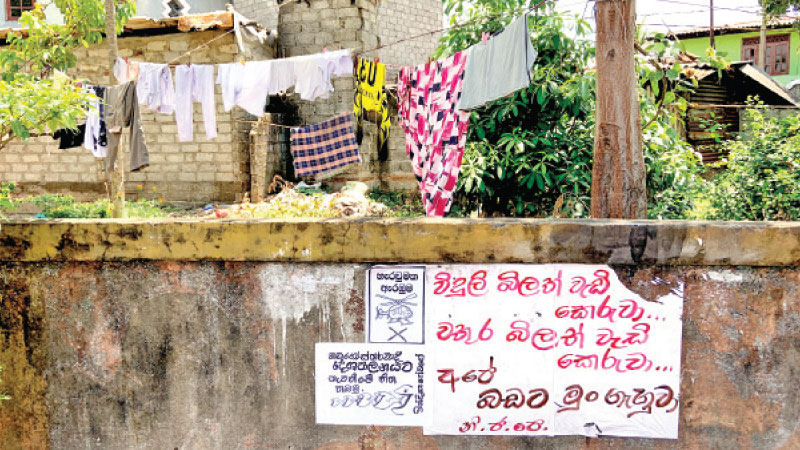With the worst of the Covid-19 pandemic and economic crisis behind us, many have been quick to categorise Sri Lanka as being in a state of economic recovery. However, for the working class poor, daily life remains unchanged. Even in Colombo where the wheels of economic development are fastest, these communities are using the same survival strategies since 2022 of cutting expenses, depending on borrowing from the informal credit market, and juggling multiple income streams just to get by.
This struggle is illustrated in this column using research from Colombo Urban Lab – Centre for Smart Future’s ongoing fieldwork, drawing from a recent household survey in Panchikawatte.
*Ranmali’s family’s hardships began with the pandemic when the fabric shop her husband was employed in closed down. Even after reopening, lower trade meant reduced wages. As the sole provider, he had no option but to borrow. Since 2020, they have cut spending on food and their children’s education.
This is the reality of Sri Lanka’s working class poor, who don’t feel the load of their financial burdens lightened, even as Sri Lanka shows signs of recovery. This is because they face existing barriers of debt, outstanding payments and other burdens that have accumulated in their lives.
According to the 2023 United Nations Development Programme (UNDP) report on Sri Lanka’s multidimensional vulnerabilities, approximately 33.4% of the populace is multidimensionally vulnerable because of debt related factors. Some household debts have accumulated as far as the start of the pandemic or earlier and includes microfinance loans, pawned jewellery, liquidating assets, leasing, or borrowing from friends or relatives.
Why people borrow
The reasons for borrowing are complex, especially after Sri Lanka’s 2022 crisis pushed many families into precarious conditions. Factors such as being stuck in cycles of debt, irregular incomes, lack of job opportunities, lack of access to formal financial institutions and the absence of adequate social protection are some of the main drivers of informal borrowing.
In December 2024, households in Panchikawatte listed debt repayment as a monthly expense, and nearly all said they would borrow or pawn jewellery in an emergency. Only a handful could rely on savings. This coincides with national research which highlights that the Western Province is second most likely to borrow for basic consumption (21.3%).
There is no solution other than borrowing – Krishnapriya*, 43.
The most common borrowing is small loans for survival, ranging from Rs. 10,000–40,000 for necessities like utilities, groceries, and children’s education. However, despite their small amounts its corresponding interest rates are high (10–20%).
In Panchikawatte, *M. P. Kavitha repays Rs. 20,000 borrowed for household needs with 10% interest. The cycle of borrowing for survival exacerbates financial precarity, making it nearly impossible to achieve financial stability sustainably.Small loans aren’t always sufficient to repay utility bills- particularly when some families have exorbitant outstanding utility bills from as far as the onset of the pandemic.
*C. Balasuriya related how after her electricity was disconnected, two of her relatives living abroad helped reinstate her connection by paying an outstanding bill of Rs. 52,000.
Money lenders or microfinance companies are the main sources for loans aimed at economic mobility or improved living conditions. Colombo has the highest district-wise reliance on money lenders (23.8%). In Panchikawatte this manifested as people borrowing Rs. 60,000–250,000 to repair three-wheelers, to pay key money for housing, or send children abroad. Farha Mohommed*, 62, borrowed Rs. 150,000 to send her son abroad and repays Rs. 4,500 weekly.
Taking loans to finance existing debt is part of the reason why so many working class families are stuck in a cycle of debt, wherein seemingly the only way out is to dig an even bigger hole.
Debt risks
However, not all borrowers are unaware of debt risks. CUL’s research shows that households recognise the dangers of high-interest borrowing. Some said that they refuse to borrow with interest and prefer seeking interest-free loans from friends or relatives in emergencies.
We first ask from the children and if that doesn’t work we’ll borrow money without interest from a neighbour – Sugandi*, 69.
While people do pawn jewellery as well, field work in December 2024 revealed that people borrowed on interest more than they resorted to pawning jewellery. Pawning jewellery for quick money was mostly employed by them during the pandemic and economic crisis, and many perhaps do not have any left to pawn.
Debt burdens falling outside the typical perimeters for borrowing, also include borrowing for social obligations. Cultural participation is a fundamental aspect of how poorer communities who rely on each other to survive, continue to thrive. As such, many take loans for cultural practices despite repayment struggles. One interviewee said that she borrowed Rs. 25,000 to pay for her mother’s three-month death anniversary (dana). This loan ultimately snowballed into an unbearable debt burden that put her family through a lot of stress and pressure. A major aspect of security for these communities is social cohesion, as they rely on their informal ties with each other more than they can on formal lending or social security networks they may not have access to.
Given this gap, community financial systems like peer borrowing and Rotating Savings and Credit Associations (ROSCAs) help stabilise their livelihoods. A ROSCA is an informal savings arrangement where members contribute a fixed amount to a collective fund at regular intervals, with each member taking turns to receive the full sum. Considering how essential these social ties are, government policies that threaten them such as the Urban Regeneration Programme and imposing selective criteria for Aswesuma should be rethought.
Despite Sri Lanka being in economic recovery, the lived realities of the working-class poor in Colombo tell a different story. Addressing their lived realities should be discussed when assessing Sri Lanka’s next step forward, as a country that should truly offer economic recovery for all.
All names have been changed
The writer is Colombo Urban Lab (CUL) Project Officer and draws from a household survey conducted in December 2024 and past research.









